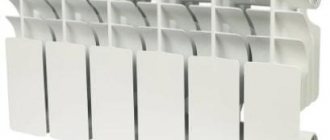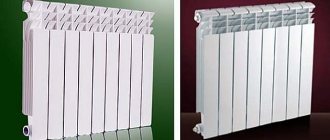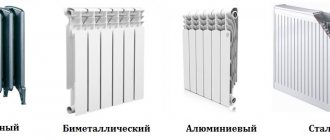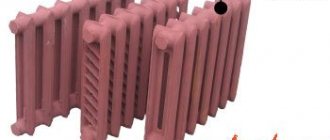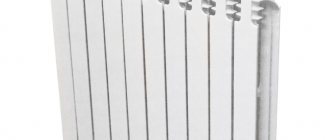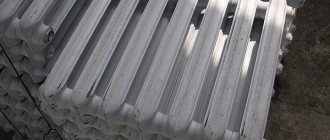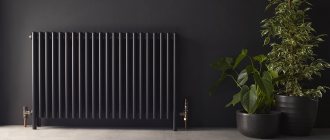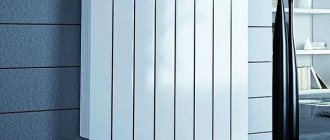The choice of heating devices for a water system always remains the prerogative of the homeowner, even when the installation is carried out by hired craftsmen. But choosing batteries based on the advice of sellers or reviews of Internet users is not easy - the former often do not understand the topic and repeat advertising slogans, the latter “praise their swamp,” which is understandable. To find out which heating radiators are best to choose for an apartment or private house, we suggest using a simple and understandable algorithm.
Instructions for choosing batteries - a simplified approach
Before you buy or order new heating radiators, you should quickly study the catalogs of large online stores. This will allow you to find out the price order and see the existing types of batteries. All convection water heating devices are divided into 4 groups:
- aluminum sectional;
- bimetallic - sectional and monolithic;
- cast iron;
- steel – panel and tubular.
Lyrical digression. You can read reviews and articles on resources that publish ratings of products from various brands. But the information will not bring much benefit - there are endless debates on forums and fake responses are written, and ratings are often compiled based on the TOP 10 manufacturers from the first pages of the search.
To select the power of heating radiators, you must first calculate the amount of heat consumed to heat each room. Calculation methods - by area, volume or heat losses of the building - are published in a separate article. How to choose the right batteries:
- Estimate the cost of a future purchase, weed out more expensive and too cheap heater options.
- Select models that you like in appearance, shape and color that fit well into your home interior. Pay attention to the height of the batteries so that they fit into the niches.
- If you live in an apartment in a high-rise building (9 floors or more), open the page with the technical characteristics of the selected radiators and find out the maximum operating water pressure - the device must withstand at least 12 Bar.
- For owners of private cottages, the pressure parameter is not of interest - models with any characteristics are suitable. If the house is heated with a wood or coal boiler, it is worth checking the maximum temperature of the coolant - the higher the figure, the better.
- Find out what connection methods are provided by the manufacturers of the selected batteries. The bottom line allows you to better hide the heating lines; with the side option, the pipes will have to be walled in the wall or left in plain sight.
- Find out the weight of the product and the installation method - floor or wall. Find out if the radiator comes with mounting brackets and liners, otherwise there will be additional costs. Radiator valves and Mayevsky tap are usually purchased separately.
To install the devices you will need footers, a Mayevsky tap with a key and hanging brackets - Make the final choice of model and determine the size of radiators by power. We will tell you how the actual heat transfer of 1 section (panel) is calculated at the end of this instruction.
Please note that we did not mention materials of manufacture and types of devices. In reality, this factor does not play a big role. Modern radiators differ little in technical parameters; only the heat transfer indicator remains important. The lower threshold of working pressure is only relevant in multi-storey buildings.
Next we will look at the design and characteristics of various batteries, comparing their advantages and disadvantages. But first, let’s dispel popular myths invented by advertisers.
Floor convectors
A new solution among heating devices is convectors hidden in the floor, consisting of a heat exchanger, a duct and a decorative grille. Their coolant pipes are copper, and their fins are aluminum. There are also models with a steel tubular core (“Breeze” from KZTO). In-floor radiators are especially good with panoramic glazing. They are used in airports, car dealerships, and sports facilities (for example, swimming pools).
+ Pros:
- Durability and simplicity of design, low weight.
- They are not subject to corrosion.
- They take up little space.
- They are practically invisible.
- Easy to install and clean.
- Uniform heating of the room.
- Protects against glass fogging.
- Minuses:
- Large installation length.
- Inability to use forced ventilation.
- Little heat dissipation.
- Uneconomical.
Manufacturers: OPLFLEX (Czech Republic), Mohlenhoff (Germany), JAGA (Belgium), IMP KLIMA (Slovenia), KZTO (Russia).
Main characteristics:
- Pressure (working) – 10-16 bar.
- Thermal power – 130-10000 watts.
- Hot water temperature (maximum) – 110-130 degrees.
Myths about heating radiators
In order to promote a particular product, three common fables were invented about heating appliances made from various materials:
- the heat transfer of aluminum radiators is significantly higher than that of steel and cast iron;
- radiators made of cast iron are massive, so they take a long time to heat up and cool down, supposedly storing heat;
- In the central heating network, water hammer and pressure occur, which only bimetallic heaters can withstand.
Note. The main established myths are listed here; we will tell you about others in the process of describing radiators.
Compared to ferrous metals - steel and cast iron - aluminum conducts heat much better. Let’s confirm with numbers: the thermal conductivity coefficient λ of aluminum products is 209 W/(m•°C), steel – 47 W/(m•°C), cast iron – only 42 W/(m•°C). Here’s the catch: heating devices are made not from pure aluminum, but from an alloy of the AK12 group - silumin, which contains 11-13% silicon and other impurities indicated in the table above.
The purpose of adding silicon is to increase the strength and corrosion resistance of the alloy. The physical properties of silumin are different, the thermal conductivity is noticeably lower - 168 W/(m•°C). Considering the thickness of the battery walls is 4-5 mm, the difference in heat transfer between aluminum and iron devices is invisible in practice. Place 2 of these radiators of the same power in a room - you will not be able to determine which one works more efficiently.
The best conductor of heat is copper. Plate baseboard heaters and copper-aluminum water convectors are made from it.
The stumbling block is the prices of copper products. The right photo shows the Thermia heater costing 70 USD. e., dimensions - 400 x 400 x 90 mm, heat flow - only 430 W.
The transfer of thermal energy from any metal battery is greatly influenced by the following factors:
- temperature and coolant flow;
- surface area of the device;
- temperature difference between the air in the room and the water in the pipes.
Reference. The difference between the average temperature of the coolant and the heated air of the room is called temperature difference (DT). The value will be useful later when calculating the power of devices.
Let's dispel the remaining myths point by point:
- When heating/cooling, the massiveness of cast iron does not matter, since its heat capacity is 9 times lower than that of the water inside (0.54 kJ/kg •°C versus 4.18 kJ/kg •°C). Therefore, the cast iron battery will cool down simultaneously with the coolant, and not longer. Silumin and steel will cool faster because they hold a much smaller volume of water.
- Water hammers simply do not happen inside district heating networks. Maximum operating pressure is 10 Bar, test pressure is 12 Bar. Modern aluminum appliances can easily withstand such pressure.
Features of the central heating system
Central heating is used to heat apartment buildings. The coolant comes from a thermal power plant or a city boiler house, which circulates through an internal pipeline using special equipment and is delivered to the apartments.
When choosing a radiator, it is important to take into account the operating features of central heating:
- changes in coolant temperature;
- the presence of rust, debris, lime and other aggressive components in the water;
- decrease in water temperature when circulating in the system (return);
- pressure surges;
- the occurrence of water hammer;
- draining water from the heating system due to repair work or the end of the heating season.
As a result of operation, the radiator is exposed to harmful factors, as a result of which the battery can burst, corrode and insufficiently heat the room.
For a long service life of the radiator, it is necessary to choose the right quality heating device.
Design and advantages of aluminum appliances
Radiators of this type are manufactured by injection molding or extrusion. The finished product is a vertical single section or a solid, non-separable battery (both varieties are produced by the well-known company Rifar). A heater of the required power is assembled from individual sections; the connection method is a threaded nipple with a gasket.
Inside the silumin radiator section, shown in section in the photo, there are 2 horizontal collectors, between them there is a vertical connecting channel of oval cross-section. The outer heat exchange part consists of convection fins coated with heat-resistant powder paint. The shape of the fins and the number of plates are determined by the manufacturer.
Reference. The height of the battery is calculated by the distance between the centers of the horizontal collectors. Aluminum products are offered in 3 standard versions - 35, 50 and 80 cm. Permissible pressure in radiators is 14...16 Bar, heat transfer of a section with an interaxial distance of 500 mm is about 190 W according to the Italian brand Global.
Advantages of aluminum alloy batteries:
- light weight;
- attractive appearance;
- efficient heat transfer is facilitated by a large surface area;
- small water capacity - 0.2...1 l depending on size;
- relatively low price 7...10 cu. e. per section, Chinese models - from 5 USD. e.
A disadvantage of aluminum is considered to be low corrosion resistance, although in practice heaters serve in apartments with central heating for 20 years. The statement should apply to private houses, where too hard water, saturated with magnesium and calcium salts, is used as a coolant.
Method of assembling a sectional heater on threaded nipples with EPDM rubber gaskets
The second disadvantage is inherent in any sectional batteries - when pouring non-freezing coolant, leaks occur at the joints. Solid modifications, for example, Rifar Monolith, do not experience such problems.
What threats does centralized heating pose?
On the one hand, supplying heat from outside is more convenient than autonomous heating - you don’t have to bother with installing the boiler and setting it up. Autumn will come, and hot water will happily run through your radiators, warming your apartment.
But not everything is so smooth in the centralized heating system:
- Water that has traveled a long way contains many chemically active impurities that can cause corrosion of pipes and radiators.
- And small particles of sludge, which inevitably fall into the coolant, scratch the batteries from the inside, wiping them to holes after a few years.
- And the water temperature is not always stable - sometimes the batteries are at room temperature, or sometimes it’s impossible to touch them.
- And the most important danger is a sudden huge surge in pressure in the heating system, the so-called water hammer. It happens, for example, for the reason that the mechanic closed the tap of the pumping station too abruptly.
Previously, they used smooth-running valves, but with the advent of ball valves, it became possible to turn off the water instantly. Water hammer also occurs when excess air gets into the pipes. A second surge in pressure can cause a lot of trouble. Weak batteries cannot withstand enormous pressure and burst, splashing boiling water, ruining furnishings and causing damage to neighbors below.
Pros and cons of bimetal
As you can easily guess from the name, heating devices are made of 2 metals - silumin and steel. Externally, the batteries are indistinguishable from aluminum sections, but inside the collectors and vertical channels there are iron tubes welded together. The steel frame is designed to solve 2 problems:
- protection of the silumin part from the chemical effects of the coolant in old centralized systems;
- increasing the reliability of the radiator by increasing the operating pressure threshold to 20...30 Atm.
For reference. There are bimetallic models with double vertical channels made to improve water flow and heat transfer. An example is the Rifar SUPReMO line of non-separable batteries, shown in the photo below.
In terms of other technical characteristics, bimetal differs little from aluminum - the power of 1 section, weight and capacity are almost the same. The operational advantages of radiators also remain, but a couple of disadvantages appear:
- the price of batteries is 30-50% higher, for example, the original bimetallic section from Global Style Plus with an axial spacing of 500 mm costs about 15 USD. e. (970 rub.);
- due to different coefficients of thermal expansion of silumin and steel, the pipe core can burst at the welded joints, making repairs and sealing the leak is unrealistic.
In a monolithic structure, the collectors of adjacent sections are connected by welding. Feature of Rifar products - 2 vertical channels
Important addition. Sometimes on sale there are defective bimetallic radiators with steel tubes embedded only inside the collectors. The vertical channel of the section remains unprotected.
Table of the best six radiator models
| Firm | Model | Dimensions, cm | Heating area, sq.m. | Price, thousand rubles |
| Royal Thermo | BILINER SILVER Steel, panel | 50 x 57 x 8.7 | 6 | 3,06 |
| Global STYLE PLUS | Style Plus 350 Bimetallic | 42.5 x 9.5 x 8 | 5 | 1,25 |
| Sira Group | Gladiator Bimetallic | 50 x 52 x 8 | 6 | 3 |
| KONNER Modem | LUX 350 Aluminum | 42 x 7.5 x 7.8 | 4 | 2,4 |
| MS-140 | MS-140 Cast iron | 20 x 58.5 x 14 | 18 (4 sections) | 5 |
| Purmo Ventil | CV22, CV33 Steel, panel | 50 x 50 x 8 | 15 | 8 |
Features of cast iron accordions
The structure of batteries made by casting from gray cast iron is well known to most homeowners. Like its aluminum “brother,” the heater is assembled from separate sections, twisted with nipples through gaskets (a long socket wrench is needed).
Cast iron batteries on the market are divided into 2 groups:
- Soviet-style products of the MS-140 brand, the center spacing is standard - 300 and 500 mm.
- Designer models cast in modern, retro style and so on. The distance between the plugs is arbitrary.
Inexpensive “accordions” of the MC series are significantly inferior to any radiators in appearance; they are used mainly in industrial premises. The heat output of the 50 cm section is 160 W, the operating pressure is up to 9 Bar, the water capacity is 1.45 liters. Cost - from 6 USD. e. (420 rub.).
The appearance of modern retro batteries (left) is strikingly different from the Soviet “accordion” MS-140 (right)
Beautiful designer batteries from different brands differ greatly in size, power and other parameters. The table below shows the characteristics and prices of decorative heaters from Czech, Turkish and Russian brands (excluding the cost of decorative shut-off valves).
Note. The numbers after the product names indicate the center distance and thickness of the heater in millimeters.
Cast iron “accordions” are reliable in operation, durable and completely resistant to corrosion. In appearance, retro radiators confidently occupy the first position among all heating devices. Now let's reveal the negative points:
- the exorbitant price of designer sections is noticeable in the table;
- cast iron is brittle and cracks under impact loads;
- solid weight of the product;
- the battery holds 2-4 times more coolant than other types of radiators.
Heating devices in the Art Nouveau style from the Czech brand Viadrus
The so-called inertia of cast iron sections is explained precisely by their increased capacity. Two liters of water cools down significantly longer than 0.2-0.6 liters in the aluminum section. Particularly heavy modifications, for example, Retro Style Anerli, are produced in a floor-standing version and are equipped with legs.
Characteristics of cast iron radiators
Cast iron heating radiators
Technical characteristics of RETRO cast iron radiators
Such batteries are the most common and well-known option for everyone, since they are installed in most standard apartments. Agree, old cast iron appliances can hardly be considered stylish and attractive. New models look better, but in terms of aesthetic indicators they are still significantly inferior to devices made from other materials.
Radiators ChM2
As you know, cast iron is very heavy. Batteries made from it weigh a lot, which cannot but affect the complexity of transportation and installation.
Let's look at their main advantages.
- Cast iron radiators are reliable and durable. They can last up to 40 years without repair, which cannot be said about batteries made from other materials.
- Cast iron cools slowly, although it warms up just as slowly, and is also resistant to corrosion.
- This metal has a high heat capacity. Heating occurs through convection.
- Such batteries can be operated even with low-quality coolant containing foreign impurities and suspensions.
- Cast iron batteries are relatively cheap (the only exception is designer models from foreign class=”aligncenter” width=”850″ height=”549″[/img] Color range of GuRaTec cast iron radiators
But cast iron also has disadvantages , including:
- significant weight;
- slow heating;
- unaesthetic.
Attention! Despite the abundance of more modern analogues, many prefer to install cast iron batteries, trusting what has been tested for decades.
Fastening cast iron radiators to walls made of various materials
Table 3. Comparison of cast iron radiators from the most well-known manufacturers
| Manufacturer/Model | Weight, kg | Volume, l | Heating area per section, m² | Power, W | Pressure, atm. | Dimensions, mm |
| 1. Konner, Modern | Up to 4.75 | Up to 0.96 | — | Up to 150 | 12 | 80x60x565 |
| 2. World Cup-3 | Up to 7 | 1,38 | 0,25 | 156 | 9 | 120x90x570 |
| 2. World Cup-2 | Up to 6.3 | 0,8-0,95 | 0,2 | 100-142 | 9 | 100x80x570 |
| 2. World Cup-1 | Up to 4.8 | 0,9 | 0,1-0,16 | 110 | 9 | 70x80x570 |
| 5. MS-140 | Up to 7.1 | 1,45 | 0,24 | 160 | 9 | 140x93x588 |
Prices for popular models of cast iron radiators
Cast iron radiators
Advantages of steel radiators
Manufacturers offer 2 options for iron batteries:
- panel - flat and profile;
- vertical tubular (sectional).
The design of a standard panel (left) and a vertical design model (right)
Comment. Both varieties are available in a designer vertical design (see photo above). Well-known brands in the post-Soviet space: Kermi, Korado, Purmo, Arbonia and others.
Heating panels are welded from stamped steel plates with a thickness of 1.2…1.5 mm. Fittings for connecting connections are installed on the side or bottom of the radiator. Convective fins are attached between the panels. Batteries are divided into types depending on the number of heating panels and profile fins, as shown in the table.
Performance indicators of panel heaters (taken according to the German radiator “Kermi” type 22, installation size 100 x 50 cm):
- permissible pressure – up to 10 bar;
- thermal power 1550 W at supply water temperature 75 °C, return water temperature - 65 °C;
- coolant volume – 5.4 l;
- unit weight – 28 kg, price – 95 USD. e. (6300 rub.).
The characteristics of tubular radiators are not too different from panel radiators. If we take a double-row Arbonia 3050/22 device, comparable in size to the Kermi option under consideration (500 x 1014 mm), we get a power of 1481 W with the same operating pressure and a weight of 25.9 kg. Only the price of the product is different - 430 USD. e.
Tubular radiators "Arbonia" in horizontal and vertical versions
Since we are considering affordable options, we will list the advantages of panel batteries:
- steel panels are the most budget option among all radiators;
- resistance to chemical corrosion;
- acceptable design and appearance;
- the one-piece design allows you to pour antifreeze into the system and not be afraid of leaks;
- the ability to select power without changing dimensions - by adding heating panels and fins (from 1 for Type 10 to 3 pieces for Type 33).
The disadvantage of radiators is the low operating pressure threshold - 6...10 Bar. We will not refute this, but we will suggest watching a video from our expert, where an inexpensive steel panel is inflated with a pressure testing pump until the weld breaks (pressure over 20 Bar):
Characteristics of bimetallic batteries
Bimetallic radiator
The main difference between bimetallic radiators is the use of two different metals in the manufacturing process - steel to create the core and aluminum to assemble the body. Thanks to this, the rod is very strong. Another advantage of such products is their high working pressure, which can reach 50 (!) atmospheres. Moreover, steel works well even with water that contains various impurities, while aluminum heats up quickly and gives off maximum heat.
Technical characteristics of bimetallic heating batteries
The main advantages of bimetallic radiators
In short, the use of two metals at once made it possible to obtain radiators that have the advantages of each of them. Therefore, it is quite obvious that the cost of these devices is the highest among all possible options.
Bimetallic radiator in section
Attention! Bimetallic batteries are used primarily for heating industrial and public facilities. In residential buildings they are rare due to their high cost.
The service life is 20-25 years, which is quite normal.
Bimetallic radiator Rifar Base Ventil 500 5 sections (bottom connection)
Table 2. Comparison of bimetallic radiators
| Manufacturer/Model | Working fluid temperature, ᵒС | Weight, kg | Volume, l | power, kWt | Operating pressure | Section dimensions, cm |
| 1. Sira Group/Gladiator-500 | 110 | 1,6 | 0,42 | 0,185 | 30 | 8x8x42.3 |
| 2.Gordi/Gordi-500 | 100 | 1,7 | 0,3 | 0,181 | 30 | 8x8x57.2 |
| . Rifar/Rifar Monolit-350 | 135 | 1,5 | 0,18 | 0,136 | 100 | 8x10x41.5 |
| 4.Tenrad/Tenrad-500 | 120 | 1,44 | 0,22 | 0,161 | 24 | 7.7x8x55 |
| 5.Global/Style-350 | 110 | 1,56 | 0,16 | 0,125 | 35 | 8x8x42.5 |
All the advantages of using bimetallic radiators are clearly expressed in the design of STOUT Space heating devices. These radiators are easy to install, they are suitable for rooms of any design and have a reliable design. The maximum pressure that a heating device can withstand is 100 atmospheres. Production is Russian, the largest in the country. Service life - 25 years, warranty from the manufacturer - 10 years. The number of sections is available from 4 to 14 - you can complete any object and select a radiator for a room of any size.
Bimetallic radiators STOUT Space
Prices for bimetallic batteries
Bimetallic batteries
How to find out the real heat transfer
When selecting heating devices in an online store, it is difficult to find real power indicators for a panel or one section. It is more profitable for sellers to declare maximum heat transfer, which is practically unattainable when heating a country cottage or apartment. According to the passport, the water temperature in the supply pipeline should reach 90 degrees, the return line - 70 °C, room air - 20 °C.
Reference. In modern household heat generators, the heating temperature is limited to 80...85 degrees.
We recommend selecting sections based on heat transfer as follows:
- Open the official website of the manufacturer of the battery you like and download the operating instructions for the device. It indicates exactly at what temperature difference DT the radiator produces the nominal amount of heat. Focus on the 70/50 °C mode.
Power of Kermi steel panels depending on size and temperature conditions - example table - If there are no instructions, take the manufacturer's data as truth and multiply the heat transfer by an increasing factor of 1.5-1.8. If you make a one and a half supply, you definitely won’t go wrong.
- Select the latest radiators of a single-pipe system with a double reserve, since they receive the least amount of thermal energy.
The most accurate selection method is to calculate heat transfer at a given temperature pressure. The calculation algorithm is described in detail in the corresponding material.
How to choose a heating radiator
We talked about the best heating radiators in 2022, and now we give the floor to an expert who will share tips on how to choose a device. Roman Sidlauskas, development director of the Russian representative office of the Italian radiator manufacturer Global Radiatori, tells the story .
This is interesting
Choosing the best electric convectors
Conclusions and recommendations
We hope the previous description helped you figure out which heating batteries are best for an apartment in terms of price and technical indicators. Finally, here are some practical tips:
- Please use the instructions at the beginning of this publication. Choose radiators that best suit your design and budget.
- The operating pressure of the coolant is important only for apartments in high-rise buildings; only bimetallic and aluminum batteries can withstand pressure above 10 bar. Any water heating devices are suitable for dachas and private cottages.
- If you are on a limited budget, feel free to buy steel panels - their heat output is not inferior to other heaters or convectors.
- For a gravity-flow system, you need to take radiators with a large cross-section of internal channels. It is better not to install stamped steel heaters, only tubular ones.
- In terms of price-quality ratio and set of operating parameters, the first place is occupied by sectional batteries made of light aluminum alloy.
- It is worth paying for bimetal when there is no confidence in the parameters of the coolant - the pressure is unknown, hard water is used.
- Try not to purchase frankly cheap radiators made from unknown material in China. They will warm, but probably not for long.
Characteristics of heaters of the same size, made of different materials - comparison table
Conclusion regarding cast iron. Heating radiators of the old type MS-90 and MS-140 are cheap, but they look unsightly. Beautifully designed models are incredibly expensive, and therefore beyond the reach of average homeowners. Cast iron is becoming rare, and the outdated “accordions” of the MC series are becoming a thing of the past.
If your budget allows you to install designer heaters, carefully select each battery according to its dimensions. It is better to place a vertical steel heating radiator in a narrow wall niche, and stylish cast iron products under the windows. It is advisable to additionally attach heavy floor-standing versions to the wall using a pair of brackets.
TOP 17 rating
Quite a few manufacturers offer their products on the Russian heating equipment market. Today, the list of the best heating radiators for an apartment includes devices from the following well-known manufacturers.
DO NOT BUY Radiators Until You See THIS!!!
- Thermo.
- Global STYLE PLUS.
- Sira.
- KONNER Modem.
- MS-140.
- FTV.
- Purmo Ventil.
- RETROstyle WINDSOR.
- Buderus Logatrend.
- Ogint Fortis.
- ROMMER Al Optima.
- ALP-500.
- Thermal Standard Plus.
- Oasis.
- KZTO.
- Lidea.
- Terma.
The heating radiators on this list are best suited for installation in an apartment in a multi-storey building.
Royal Thermo
One of the largest manufacturers of heating systems in Eurasia. The main production facilities of the Italian branch are located in the Vladimir region. The range of heating radiators produced by the company consists of 4 standard panel models with side and bottom connections.
Bimetallic batteries can be built into a heating system with any aggressive coolant. Aluminum models use a new technology for attaching the plug to the body without welding, which is the best today.
Global STYLE PLUS
The largest Italian manufacturer is represented on the Russian market with a wide range of heating batteries. Global Style Plus bimetallic radiators are installed in heating systems in the same way as steel appliances.
Using nipples, you can easily increase or decrease the number of sections directly at the installation site. The manufacturer's range also includes cast iron and steel models.
Sira
The Italian company Sira Group has been operating since 1959. Branches of its production facilities are located in different countries, including Russia.
The company specializes in bimetallic heating radiators. In the Russian heating engineering market it is known for such models as Gladiator.
KONNER Modem
This is a high-quality manufacturer of heating equipment, including aluminum batteries. Models are specially designed for individual heating systems. Their work is characterized by high heat transfer, reliability and ease of operation.
Radiators are manufactured according to international quality standards. All products are certified for compliance with Russian quality standards.
MS-140
The manufacturer PJSC Lugansk Foundry and Mechanical Plant still produces “Soviet” cast iron batteries. Despite the fact that the products have a long history, cast iron radiators are in great demand on the Russian market.
They are installed in rooms where there are no increased requirements for the appearance of devices. These are technical premises, workshops, etc. Their attractiveness lies in their high thermal characteristics and inexpensive price.
Kermi FTV
Kermi steel panel radiators attract buyers with a unique combination of affordable prices and beautiful design.
Products can be divided into two groups - these are devices with side and bottom connections. All of them are equipped with Mayevsky taps, plugs and wall mounting kits.
Purmo Ventil
The Finnish company Purmo Ventil is one of the leading European suppliers of heating systems, including apartment water heating batteries. The company is constantly involved in the development of innovative solutions for climate control equipment.
Panel steel radiators with convection elements at the ends are closed with protective strips and can be connected both from the side and from the bottom. To do this, there are two lower holes with internal threads in the panel or two inlets for hot water on the sides.
A distinctive feature of the models is the presence of thermostatic valve inserts.
RETROstyle WINDSOR
For many years, the Russian company Retrostyle has been producing the best cast iron radiators, made in the popular retro design style. The products are more intended for private houses and apartments in luxury high-rise new buildings.
The Windsor line represents batteries consisting of two-column sections on legs and with upper convection ears. Twisted relief patterns decorate the surface of the sections, which gives them special elegance and sophistication.
Buderus Logatrend
, located in the Saratov region, is part of the Bosch manufacturing company together with Buderus Logatrend.
The company specializes in the production of panel steel radiators of various sizes. Heating panels measuring 500 x 500 mm are very popular. At the same time, the plant produces wall-mounted boilers that are most compatible with heating radiators of the same name.
Ogint Fortis
The company's main production facilities are located in Southeast Asia. Ogint Fortis products include cast iron, bimetallic and aluminum radiators. Cast iron models are very popular in Russia.
They have a modern design. They are supplied to the market assembled from 7 – 10 sections. Designed for use with hot water and antifreeze. Developers purchase them in large quantities for installation in apartments in multi-storey new buildings.
Products undergo pre-sale tests and are supplied as a complete set for wall mounting.
ROMMER Al Optima
Aluminum radiators from ROMMER Al Optima are designed for use both in individual heating systems and in apartment buildings. The manufacturer strives to achieve maximum implementation of the best thermal conductivity qualities of aluminum in its products.
All products are manufactured in a trauma-safe design with rounded surfaces, which allows them to be installed in rooms with small children. The sections made by extrusion casting are capable of withstanding system pressures of up to 16 atm.
RIFAR ALP-500
The Russian company Rifar is the largest manufacturer of two lines of heating batteries. These are high-quality bimetallic and aluminum sectional radiators. The products have proven themselves well in almost all regions of Russia from Kaliningrad to Siberia and the Far East.
Of the entire range of heating devices, the bimetallic model Rifar ALP-500 attracts attention. The radiator constantly takes the best places in Russian ratings. The simple and at the same time beautiful design of the device can suit any apartment interior. Dimensions: 570 x 1360 x 75 mm. Lateral connection. Estimated price 4.4 thousand rubles.
Thermal Standard Plus
Aluminum radiators Thermal Standard Plus 500 are products of Zlatmash JSC, located in the Chelyabinsk region. The batteries, consisting of 5 sections, are manufactured as a single monolithic structure using the extrusion method of aluminum-magnesium alloy under a pressure of 2000 tons.
Due to this, the external and internal surfaces of the products are mirror clean. In addition to the standard configuration, models can have from 3 to 10 sections. The 5-section battery has dimensions of 531 x 73 x 395 mm.
Oasis
The production facilities of the Russian company Oasis are located in China and Volgograd. The company specializes in the production of aluminum and bimetallic radiators made by extrusion of aluminum alloy.
The devices are prefabricated products from several sections. The company sells products section by section with an installation kit. The BS 500/100 model is especially popular. Color white, maximum working pressure 25 atm. Weight of 1 section – 1.7 kg. Compatible with any centralized heating systems in apartment buildings.
KZTO
The Kimry Heating Equipment Plant "Radiator" is known for its original products. These are steel tubular radiators. The company specializes in the manufacture of heating equipment for individual orders.
In the assortment of factory products you can always find radiator and angular radiators with central or spaced bottom connections with individual installation of devices. "Harmony" radiators, coated with white polymer, can withstand pressure up to 15 atm.
You can order wall-mounted radiators with a bottom right or left connection, complete with plugs and a built-in thermal valve, from the factory or its distributor. Upon request, the company will produce floor heating radiators on legs with the same set of components.
Lidea
In addition to agricultural implements and equipment, Belarusian manufactures high-quality steel panel radiators. Products are exported to almost all CIS countries and foreign countries.
Steel heating radiators are produced in both wall-mounted and floor-mounted versions. The devices are well compatible with centralized heating systems of any complexity. Developers are attracted by the inexpensive price, reliability and durability of the products.
They equip new apartment buildings with them. The plant produces heaters in two lines - these are panel steel radiators “Lidea Compact” with a side connection and “Lidea Universal” with a bottom coolant input.
The products, while maintaining the quality characteristics of the European level, are much cheaper than their analogues.
Terma
The Polish company Terma is a manufacturer of designer decorative radiators. The company's products are known in more than 40 countries around the world, including Russia. Original heating radiators can be installed by owners of luxury housing - in apartments of premium houses and mansions.
Designer models of the Terma brand, with their exclusive appearance, carry, in addition to the standard function, an aesthetic load. A wide range of colors of products, their unusual design solutions will turn any interior into a beautiful art-design space.
How to determine the required power of a heating device
To make your apartment comfortable in winter, you need to choose the right radiator power. The power of a classic sectional device will depend on the number of sections. When calculating, the following factors must be taken into account:
- the material of the walls in the house is brick or concrete;
- area of rooms;
- the number of windows and their location on the cardinal points;
- number of external walls;
- window quality;
- use of screens for radiators.
Attention: for a standard room with a three-meter ceiling height, having one door and one window, a radiator power of 90 to 125 W will be required per square meter.
The required number of sections will depend on the material the radiator is made of. Power of one section of different types of batteries:
- Cast iron - from 80 to 150 W;
- Aluminum - 190 W;
- Bimetallic – 200 W;
- Steel - from 450 to 5700 W (meaning the power of the entire battery).
What parameters should you use to choose radiators for an apartment?
Now, knowing the weak points of central heating, you can already imagine what requirements good batteries must meet. Let's list them.
1. For radiators, the pressure declared by the manufacturer must exceed the pressure (both the working pressure and one and a half times the test pressure) in the heating system. Let's look at the numbers as an example. In five-story buildings with an old layout, this parameter is no more than 5 - 8 atmospheres. Modern multi-storey buildings are heated under pressure of up to 12 - 15 atmospheres.
2. Separately, we note the ability to resist water hammer. Because when living in an apartment, it is difficult to protect yourself from pressure surges in the heating; it is better to prevent trouble in advance. By the way, if you often hear humming and clicking noises from your batteries, contact your utility service. The pressure seems to be playing tricks in the system.
3. The quality of water in the domestic heating system is unimportant, so the batteries must withstand its “chemical attack” with honor without collapsing. It is necessary to use radiators with a special coating on the inside or chemically neutral material for the walls. And their thickness must be such that particles of sand and small pebbles do not rub it, acting like emery.
4. When deciding which radiators are best for an apartment, let’s not forget about their main function - to heat. That is, it is preferable to choose devices that have greater heat transfer.
5. Let’s not ignore the design of radiators - few people are satisfied with the ugly, poorly shaped cast-iron monsters that stood everywhere in Soviet times. I would like the radiators to harmoniously complement the decoration of the rooms - today this is quite possible.
6. The last parameter is the duration of service. No comments are needed here. The less often you have to bother with installing these bulky and rather expensive devices, the more profitable it is for the owners.
